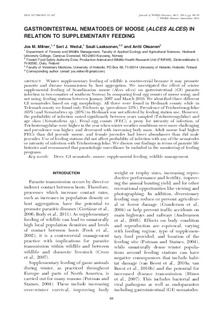Gastrointestinal nematodes of moose (Alces Alces) in relation to supplementary feeding
Peer reviewed, Journal article

Åpne
Permanent lenke
http://hdl.handle.net/11250/134520Utgivelsesdato
2013Metadata
Vis full innførselSamlinger
Originalversjon
Milner, J. M., Wedul, S. J., Laaksonen, S., & Oksanen, A. (2013). Gastrointestinal nematodes of moose (Alces Alces) in relation to supplementary feeding. Journal of Wildlife Diseases, 49(1) 10.7589/2011-12-347Sammendrag
Winter supplementary feeding of wildlife is controversial because it may promote
parasite and disease transmission by host aggregation. We investigated the effect of winter
supplemental feeding of Scandinavian moose (Alces alces) on gastrointestinal (GI) parasite
infection in two counties of southern Norway by comparing fecal egg counts of moose using, and
not using, feeding stations between January 2007 and March 2010. We identified three different
GI nematodes based on egg morphology. All three were found in Hedmark county while in
Telemark county we found only Trichuris sp. (prevalence 33%). Prevalence of Trichostrongylidae
(65%) and Nematodirus sp. (26%) in Hedmark was not affected by feeding station use. However,
the probability of infection varied significantly between years sampled (Trichostrongylidae) and
age class (Nematodirus sp.). Fecal egg counts (FEC), a proxy for intensity of infection, of
Trichostrongylidae were higher in the year when winter weather conditions were more challenging
and prevalence was higher, and decreased with increasing body mass. Adult moose had higher
FECs than did juvenile moose, and female juveniles had lower abundances than did male
juveniles. Use of feeding stations did not affect probability of infection with any of the nematodes
or intensity of infection with Trichostrongylidae. We discuss our findings in terms of parasite life
histories and recommend that parasitologic surveillance be included in the monitoring of feeding
programs.